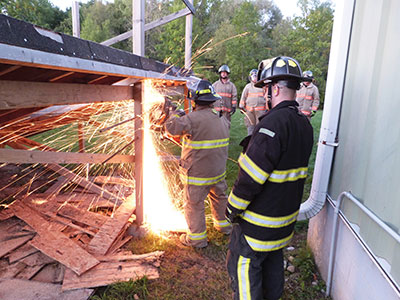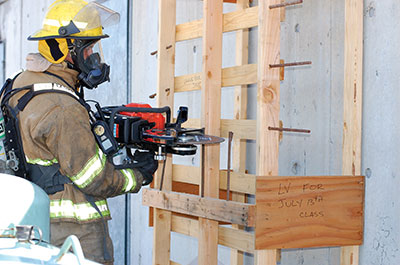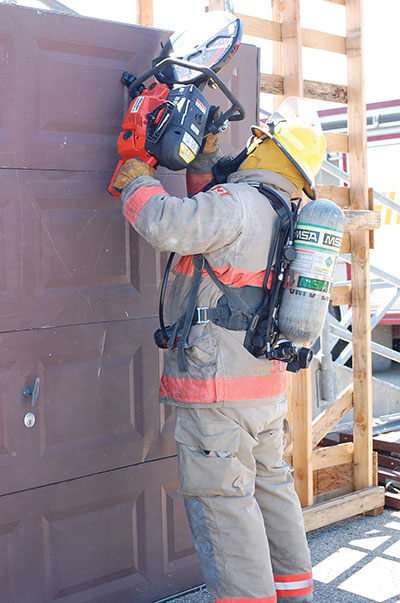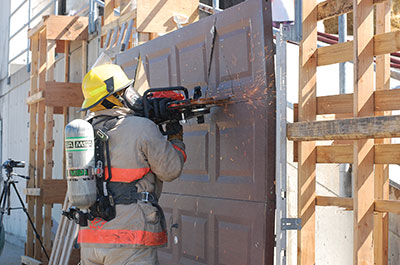
Features
Training
Back to Basics: December 2013
In the November issue, we discussed the rotary saw and its effectiveness on the fire ground. Now, we will review the saw’s practical applications.
November 22, 2013
By Mark van der Feyst
In the November issue, we discussed the rotary saw and its effectiveness on the fire ground. Now, we will review the saw’s practical applications.
The first consideration is safety. As mentioned in November, the rotary saw turns three times faster than a vent saw, making the small engine work faster and creating more noise. However, most of the noise comes from the contact between the saw blade and the material being cut. Depending on the way you hold the saw, the noise can be enough to cause temporary hearing loss. It is a good idea to wear hearing protection when using the saw.
 |
|
| Photo 1: A good flow of sparks is an indicator that the blade is cutting properly. However, these sparks can also present a safety hazard, so the proper protection must be worn at all times. Photo by Mark van der Feyst |
|
 |
|
| Photo 2: When using the saw to perform a cut at mid-height, make use of your whole upper body by resting the saw on your forearm, as if you are cradling a baby. Photo by Olivia D’Orazio
|
|
 |
|
| Photo 3: Be sure to have a partner to whom you can pass the cutting operation when you become fatigued. Photo by olivia d’orazio |
|
 |
|
| Photo 4: When cutting at head or shoulder height, the firefighter is often exposed to the extreme noise produced by the saw. As a precaution, always wear the appropriate PPE. Photo by Olivia D’Orazio Advertisement
|
You should also consider the sparks that are created when cutting metal-like material with the saw. As seen in photo 1, a good flow of sparks is an indication that the blade is cutting properly. However, this action also sends sparks and other debris flying toward the saw operator. Users should be sure to wear proper PPE to prevent minor burns from the sparks. Also, be sure that the blade shroud is positioned properly to deflect the sparks away from the operator’s face.
Another safety concern is the rotating blade. With the blade spinning on its vertical axis, centrifugal force is created. This makes the operator feel as if the saw wants to move away from him. The saw produces centrifugal force when it is not being held straight up. Hold the saw upright at all times.
Even when the blade is held straight, it can be a cutting hazard to other firefighters while it is spinning. When the cutting operation has been completed, the saw blade will not stop automatically as it does on a vent saw or on a saw that has an electric brake. The blade will continue to spin freely until it stops by force or until it loses enough momentum and stops on its own. The operator will need to bury the blade into some type of material next to the cutting area to stop the blade.
Anyone using a rotary saw should maintain a circle of safety; ensure that there is enough space around the saw and the operator so that no other rescuers directly interfere with or are affected by the cutting operation.
Using a rotary saw for lengthy cutting operations can cause a firefighter to become fatigued. When working in pairs, it is a good idea to take turns performing the cutting operation.
Finally, firefighters should consider the different ways to hold the rotary saw. Grab handles are positioned all around the saw. When using the saw to perform a cut at mid-height, it is best to rest the saw on your forearm as if you are cradling a baby (see photo 2). This allows you to use your whole upper body to hold the saw and to gain better control over it.
To make a cut above your head, as in photo 3, use the provided grab bar to hold the saw in position while cutting. This will be fatiguing for the firefighter, so be sure to trade off to another firefighter when fatigue sets in.
When cutting at head or shoulder height, as shown in photo 4, the fire-fighter should rest the saw on his shoulder if possible or lock one arm underneath the saw to hold it in position. Be aware, however, that this technique will expose the firefighter to the extreme noise produced by the saw.
No matter how you hold the rotary saw, familiarity with those positions and methods will be an asset. If your fire department has a rotary saw, train with it to become familiar with the physical challenges it creates, the best ways to hold it and the necessary safety considerations.
Mark van der Feyst is a 14-year veteran of the fire service. He works for the City of Woodstock Fire Department in Ontario. Mark instructs in Canada, the United States and India, and is a local-level suppression instructor for the Pennsylvania State Fire Academy and an instructor for the Justice Institute of B.C. E-mail Mark at Mark@FireStarTraining.com
Print this page